Nicotinamide adenine dinucleotide-dependent binding of the neuronal Ca2+ sensor protein GCAP2 to photoreceptor synaptic ribbons
- PMID: 20463219
- PMCID: PMC3900572
- DOI: 10.1523/JNEUROSCI.3701-09.2010
Nicotinamide adenine dinucleotide-dependent binding of the neuronal Ca2+ sensor protein GCAP2 to photoreceptor synaptic ribbons
Abstract
Guanylate cyclase activating protein 2 (GCAP2) is a recoverin-like Ca2+-sensor protein known to modulate guanylate cyclase activity in photoreceptor outer segments. GCAP2 is also present in photoreceptor ribbon synapses where its function is unknown. Synaptic ribbons are active zone-associated presynaptic structures in the tonically active photoreceptor ribbon synapses and contain RIBEYE as a unique and major protein component. In the present study, we demonstrate by various independent approaches that GCAP2 specifically interacts with RIBEYE in photoreceptor synapses. We show that the flexible hinge 2 linker region of RIBEYE(B) domain that connects the nicotinamide adenine dinucleotide (NADH)-binding subdomain with the substrate-binding subdomain (SBD) binds to the C terminus of GCAP2. We demonstrate that the RIBEYE-GCAP2 interaction is induced by the binding of NADH to RIBEYE. RIBEYE-GCAP2 interaction is modulated by the SBD. GCAP2 is strongly expressed in synaptic terminals of light-adapted photoreceptors where GCAP2 is found close to synaptic ribbons as judged by confocal microscopy and proximity ligation assays. Virus-mediated overexpression of GCAP2 in photoreceptor synaptic terminals leads to a reduction in the number of synaptic ribbons. Therefore, GCAP2 is a prime candidate for mediating Ca2+-dependent dynamic changes of synaptic ribbons in photoreceptor synapses.
Figures

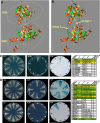
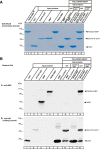

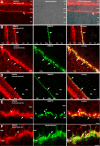

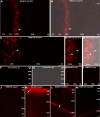


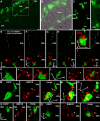
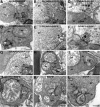
Similar articles
-
Overexpression of guanylate cyclase activating protein 2 in rod photoreceptors in vivo leads to morphological changes at the synaptic ribbon.PLoS One. 2012;7(8):e42994. doi: 10.1371/journal.pone.0042994. Epub 2012 Aug 13. PLoS One. 2012. PMID: 22912773 Free PMC article.
-
ArfGAP3 is a component of the photoreceptor synaptic ribbon complex and forms an NAD(H)-regulated, redox-sensitive complex with RIBEYE that is important for endocytosis.J Neurosci. 2014 Apr 9;34(15):5245-60. doi: 10.1523/JNEUROSCI.3837-13.2014. J Neurosci. 2014. PMID: 24719103 Free PMC article.
-
Presynaptic [Ca(2+)] and GCAPs: aspects on the structure and function of photoreceptor ribbon synapses.Front Mol Neurosci. 2014 Feb 6;7:3. doi: 10.3389/fnmol.2014.00003. eCollection 2014. Front Mol Neurosci. 2014. PMID: 24567702 Free PMC article. Review.
-
Multiple RIBEYE-RIBEYE interactions create a dynamic scaffold for the formation of synaptic ribbons.J Neurosci. 2008 Aug 6;28(32):7954-67. doi: 10.1523/JNEUROSCI.1964-08.2008. J Neurosci. 2008. PMID: 18685021 Free PMC article.
-
Dual use of the transcriptional repressor (CtBP2)/ribbon synapse (RIBEYE) gene: how prevalent are multifunctional genes?Trends Neurosci. 2001 Oct;24(10):555-7. doi: 10.1016/s0166-2236(00)01894-4. Trends Neurosci. 2001. PMID: 11576649 Review.
Cited by
-
EF hand-mediated Ca- and cGMP-signaling in photoreceptor synaptic terminals.Front Mol Neurosci. 2012 Feb 29;5:26. doi: 10.3389/fnmol.2012.00026. eCollection 2012. Front Mol Neurosci. 2012. PMID: 22393316 Free PMC article.
-
High-resolution optical imaging of zebrafish larval ribbon synapse protein RIBEYE, RIM2, and CaV 1.4 by stimulation emission depletion microscopy.Microsc Microanal. 2012 Aug;18(4):745-52. doi: 10.1017/S1431927612000268. Epub 2012 Jul 26. Microsc Microanal. 2012. PMID: 22832038 Free PMC article.
-
The Disease Protein Tulp1 Is Essential for Periactive Zone Endocytosis in Photoreceptor Ribbon Synapses.J Neurosci. 2016 Feb 24;36(8):2473-93. doi: 10.1523/JNEUROSCI.2275-15.2016. J Neurosci. 2016. PMID: 26911694 Free PMC article.
-
Overexpression of guanylate cyclase activating protein 2 in rod photoreceptors in vivo leads to morphological changes at the synaptic ribbon.PLoS One. 2012;7(8):e42994. doi: 10.1371/journal.pone.0042994. Epub 2012 Aug 13. PLoS One. 2012. PMID: 22912773 Free PMC article.
-
Identification and immunocytochemical characterization of Piccolino, a novel Piccolo splice variant selectively expressed at sensory ribbon synapses of the eye and ear.PLoS One. 2013 Aug 6;8(8):e70373. doi: 10.1371/journal.pone.0070373. Print 2013. PLoS One. 2013. PMID: 23936420 Free PMC article.
References
-
- Ames JB, Dizhoor AM, Ikura M, Palczewski K, Stryer L. Three-dimensional structure of guanylyl cyclase activating protein-2, a calcium-sensitive modulator of photoreceptor guanylyl cyclases. J Biol Chem. 1999;274:19329–19337. - PubMed
-
- Ashery U, Betz A, Xu T, Brose N, Rettig J. An efficient method for the infection of adrenal chromaffin cells using the Semliki Forest virus gene expression system. Eur J Cell Biol. 1999;78:525–532. - PubMed
-
- Balasubramanian P, Zhao LJ, Chinnadurai G. Nicotinamide adenine dinucleotide stimulates oligomerization, interaction with E1A and an intrinsic dehydrogenase activity of CtBP. FEBS Lett. 2003;537:157–160. - PubMed
-
- Barnes CJ, Vadlamudi RK, Mishra SK, Jacobson RH, Liu F, Kumar R. Functional inactivation of a transcriptional corepressor by a signalling kinase. Nat Struct Biol. 2003;10:622–628. - PubMed
Publication types
MeSH terms
Substances
Grants and funding
LinkOut - more resources
Full Text Sources
Miscellaneous
